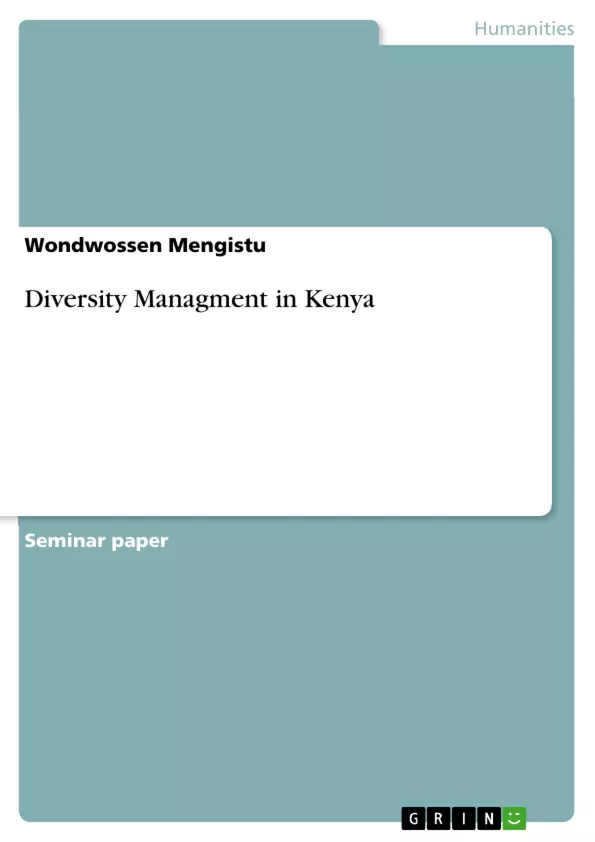After the Cold War and the transition towards democracy, inter-state conflict became prevalent, especially in Africa. Although Kenya is considered to be peaceful unlike her neighbors, a closer scrutiny reveals an unprecedented wave of internal and cross-border conflicts. These conflicts - mainly manifesting as political, economic; conflicts over natural resources, land and tribal clashes and lately terrorism - are sending signals that all is not rosy as the outside world has been erroneously been made to believe. It has experienced ethnic political violence around election periods frequently. The study investigates factors contributing to diversity related conflict in Kenya. It examined literatures on ethnicity, politics, democratic transition and political violence and the 2010 constitution to understand the nature of recurrent diversity related political problem in Kenya. The study found that in periods of political competition such as elections, political elites mobilize Kenyans along ethnic lines, which are perceived to be established voter blocs to ensure a victory to the highest office. The deliberate use of ethnicity is in line with the instrumentalist theory. Thus, this paper tries to recommend policy alternative to tackle the current diversity related problems in Kenya.
Inhaltsverzeichnis (Table of Contents)
- Kenya A multi- national state
- The Nature and scope of Diversity
- Nature and salient feature of Kenyan state.
- Management of Diversity in Kenya
- Factors that incite diversity-based conflicts in Kenya
- Approaches to the Management of Diversity in Kenya
- Current challenges in Kenya
- Insecurity issue in Kenya
- Unequal growth in Kenya
- Corruption
- Diplomatic relation with neighboring countries:
- Kenya's intervention in Somalia a shift in diplomatic approach from soft power to hard power.
Zielsetzung und Themenschwerpunkte (Objectives and Key Themes)
This paper analyzes the management of diversity in Kenya, focusing on the nature of diversity, factors that incite conflict, and approaches to managing it. The paper also examines current challenges and the country's diplomatic relations with its neighbors.
- The nature of diversity in Kenya, including ethnic, linguistic, religious, and socio-economic diversity.
- Factors that incite diversity-based conflicts, such as identity politics, negative ethnicity, and political manipulation.
- Approaches to managing diversity in Kenya, focusing on constitutional provisions and other strategies.
- Current challenges in Kenya, including issues of insecurity, unequal growth, and corruption.
- Kenya's diplomatic relations with its neighboring countries, with a focus on the country's involvement in Somalia.
Zusammenfassung der Kapitel (Chapter Summaries)
The first chapter explores the nature and scope of diversity in Kenya, highlighting the country's ethnic, linguistic, religious, and socio-economic heterogeneity. It examines the challenges posed by this diversity, particularly in terms of ethnic rivalries and political dominance.
The second chapter delves into the management of diversity in Kenya, focusing on factors that incite diversity-based conflicts. This section examines the role of identity politics, negative ethnicity, and political manipulation in exacerbating tensions.
The third chapter explores the current challenges facing Kenya, including issues of insecurity, unequal growth, and corruption. These challenges are presented as significant obstacles to the country's development and stability.
The fourth chapter examines Kenya's diplomatic relations with its neighboring countries, focusing on the country's intervention in Somalia. This section analyzes the shift in Kenya's diplomatic approach from soft power to hard power.
Schlüsselwörter (Keywords)
The primary focus of this text is on the management of diversity in Kenya, encompassing ethnic diversity, political processes, identity politics, conflict management, security challenges, and diplomatic relations.
- Quote paper
- Wondwossen Mengistu (Author), 2016, Diversity Managment in Kenya, Munich, GRIN Verlag, https://www.grin.com/document/378986



